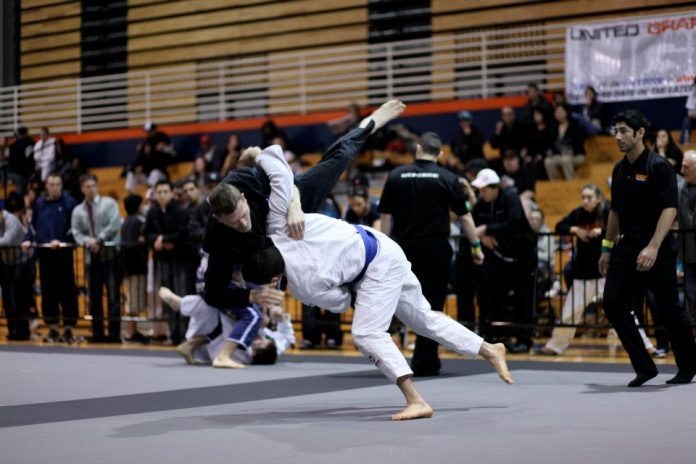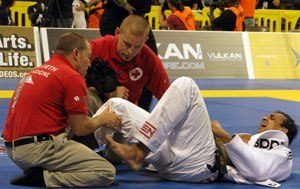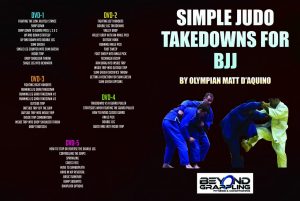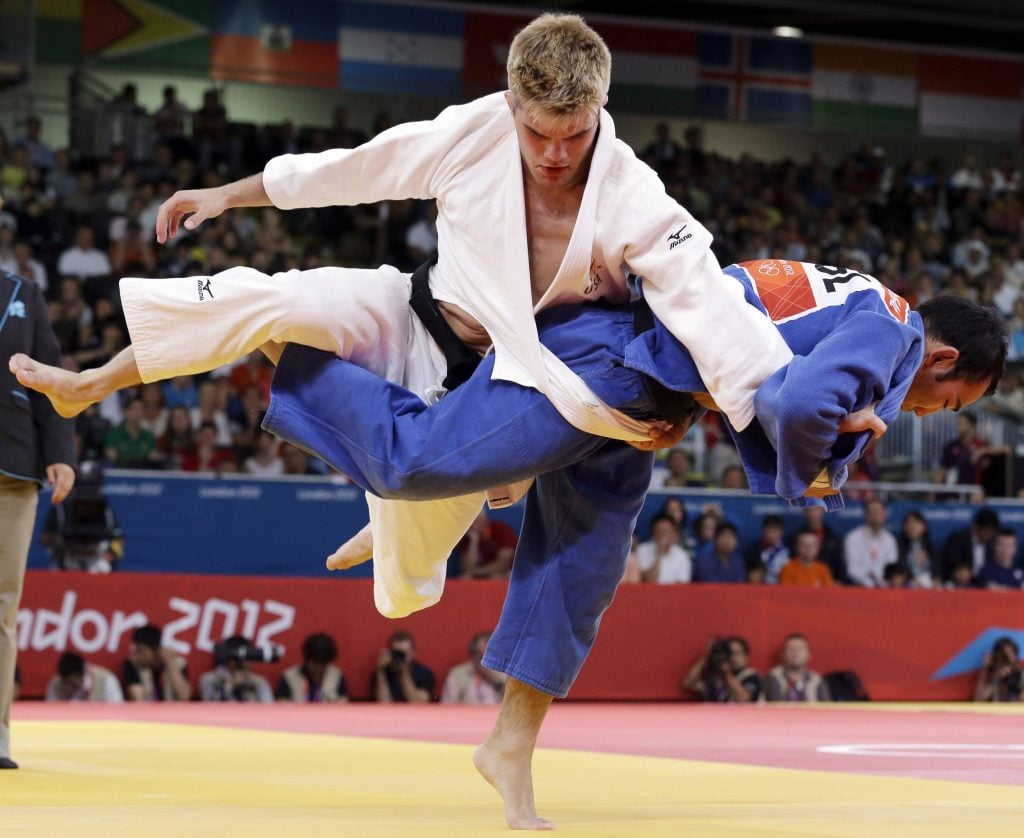
Now that leg locks are no longer the scariest technique in Jiu-Jitsu, we all needed a new culprit. Or better said an old one. Training takedowns in BJJ is usually not a priority for most people. Even those that compete a lot, tend to develop a lot more attention to the ground aspect. In that sense, we tend to look at grappling on the ground as quantum physics and training takedowns as calculus 101. Taking takedowns for granted is what makes them dangerous in BJJ. That said, they remain the number one source of really nasty, sometimes career-ending injuries in any martial art that utilizes them. Still, we most definitely need them if we’re to ever get to the ground. So, how do we proceed?
The one main difference between training leg locks and takedowns in BJJ is how we train them. With leg locks, we tend to stay on the ground and look for dominant positioning. In that sense, it is clear who is attacking and who is defending. On the feet, we face many more unpredictable variables. The fact that we’re on the feet makes things a lot more complicated, mainly due to gravity. Three the fact that we”re actually trying to get to the ground, so you can throw in inertia as well. Plus, takedown exchanges tend to get really scrappy, sometimes so much so that it is difficult to know who’s attacking and who’s defending. Couple this with how much people tend to slack when it comes to takedowns and the recipe for disaster is complete.
The Risks Of Training Takedowns in BJJ
Takedown training, specific sparring or live rolling with takedowns are the leading causes of injuries in grappling. In a sport where the goal is to stretch and crank people’s limbs, this seems contrary to common sense. However, it is not. To put it bluntly, we train BJJ, which is a ground fighting grappling martial art. Takedowns make up just a portion of Jiu-Jitsu. The trouble is that we think we can master takedowns in BJJ similarly to all other moves. this is where we’re painfully (literally) wrong.

Speaking of injuries during takedown training, you can pretty much get them all. Two of my more serious injuries come from underestimating takedowns. I have a torn ACL in my shoulder and I had a cracked tibia that required a cast. Compared to others, I got off lightly. Torn ligaments, broken joints, cracked ribs are all a part of takedown training. And they’re not even the worst. neck injuries are also very often the result of flawed takedown attempts.
However, it is not that takedowns in BJJ are not safe. It is how we approach them that makes them dangerous.
Safe Takedown Techniques
So, how do we find a way to train takedowns safely? One obvious solution is toe train like wrestlers and Judokas do. But then, we’d have to train only takedowns. Not really a viable option, is it?
Something that actually does work is choosing the takedowns you actually do train carefully. Namely, high-percentage takedowns do not have to be the highest risk ones. Quite the contrary. Let’s use wrestling as an example here. Suplexes are cool and everything but they’re more dangerous than they are effective. The absolute highest percentage moves are upper body manipulations! Yes, that’s right, no shots. Duck unders, Russian ties and armdrags are by far the most effective wrestling techniques! Not only that but they’re perfect for BJJ, where headlocks, guillotines, and back control are actually desired destinations.
Not forgetting about Judo, they also have a safer version of takedown options. While Uchi Matas and other crazy throws you see at the Olympics are beyond cool, they also require close to a lifetime to perfect. Instead, extremely basic footsweeps are the much higher-percentage takedowns in BJJ. Moreover, going underneath an opponent is also perfect for BJJ. Stuff like Tomoe Nage or Sumi Gaeshi are safe, eventually, get you into the mount, and in the worst case scenario, will force you to pull guard instead. Much better than busting your knee with some crazy throw attempt.

Takedown Training Rules
All of that aside, training takedowns in BJJ does not have to exclude the use of certain techniques. Of course, there’s a reason why moves like suplexes and scissor takedowns (Kani Basami) are forbidden. But Uchi Matas, power doubles, etc are not, and you can still train them, You just need to establish some training ground rules.
Rule number one is to always take into account prior injuries. There’s not really much sense in training power doubles with a D1 wrestler partner if you have bad knees right? Nor should you look forward to drilling hip throws with messed up shoulders. Bad hips, neck trouble, elbow injuries all impact how you can move. Make sure you choose the takedowns that allow you to spare your affected body parts.

Rule number three is to never stop drilling takedowns. You don’t have to train them like a Judoka or wrestler, but keep drilling those that you like often as possible. That means at the very least once a week, preferably more.
Finally, some live rolling rules. To begin with, the above three need to apply before you even get into live rolling with takedowns. Next, make sure you make it clear that there should be no “freestyling”. Both you and your partner should stick to clean moves, you’ve both done before.
Wrapping Up
Training takedowns is most definitely quite risky, mostly due to bad training habits. Improving the way you train takedowns in BJJ, along with choosing the right moves for your body is going to make a world of difference. You’ll not only get better at takedowns, but you’ll even master some of the riskier ones without risking any limbs. Make sure you are smart about your takedown training and it won’t be any more dangerous than training heel hooks.
Double Leg Takedown – How to Do It & The Most Common Mistakes
https://bjj-world.com/how-to-make-single-leg-takedown-work/


![Darce Choke Encyclopedia – Origins, Mechanics and Variations [2025] BJJ, choke, Brabo, BJJ Darce Choke, D'arce Choke, Darce BJJ Choke](https://bjj-world.com/wp-content/uploads/2017/11/JungPoirierLeeYahoo-218x150.jpg)









![No-Gi Grapplers Guide To Front Headlock Joel Bane DVD Review [2025] No-Gi Grapplers Guide To Front Headlock Joel Bane DVD Review](https://bjj-world.com/wp-content/uploads/2025/03/no-gi-front-headlock-joel-bane-dvd-review-218x150.png)

![Get Off My Legs Gringo Craig Jones DVD Review [2025] Get Off My Legs Gringo Craig Jones DVD Review](https://bjj-world.com/wp-content/uploads/2025/03/get-off-my-legs-gringo-craig-jones-dvd-review-218x150.png)

![Leg Lock Entries Helena Crevar DVD Review [2025] Leg Lock Entries Helena Crevar DVD Review](https://bjj-world.com/wp-content/uploads/2025/03/leg-lock-entries-helena-crevar-dvd-review-218x150.png)
![Special K Guard Neil Melanson DVD Review [2025] Special K Guard Neil Melanson DVD Review](https://bjj-world.com/wp-content/uploads/2025/03/special-k-guard-neil-melanson-dvd-review-218x150.png)
![Leg Lock Entries Helena Crevar DVD Review [2025] Leg Lock Entries Helena Crevar DVD Review](https://bjj-world.com/wp-content/uploads/2025/03/leg-lock-entries-helena-crevar-dvd-review-324x235.png)
![A Blueprint For Smeshing Khabib Nurmagomedov DVD Review [2024] A Blueprint For Smeshing Khabib Nurmagomedov DVD Review](https://bjj-world.com/wp-content/uploads/2024/10/blueprint-for-smeshing-khabib-nurmagomedov-dvd-review-100x70.png)
![Higher Tripod Passing Craig Jones DVD Review [2025] Higher Tripod Passing Craig Jones DVD Review](https://bjj-world.com/wp-content/uploads/2025/02/higher-tripod-passing-craig-jones-dvd-review-100x70.png)
![Total Domination Top Control Mariusz Domasat DVD Review [2024] Total Domination Top Control Mariusz Domasat DVD Review](https://bjj-world.com/wp-content/uploads/2024/09/domination-top-control-mariusz-domasat-dvd-review-100x70.png)

![Slip N Slide Into Victory Julián Espinosa DVD Review [2025] Slip N Slide Into Victory Julián Espinosa DVD Review](https://bjj-world.com/wp-content/uploads/2025/01/slip-n-slide-into-victory-julian-espinosa-dvd-review-100x70.png)







![Systematically Attacking The Crucifix Gordon Ryan DVD Review [2024] Systematically Attacking The Crucifix Gordon Ryan DVD Review](https://bjj-world.com/wp-content/uploads/2024/10/systematically-attacking-the-crucifix-gordon-ryan-dvd-review-100x70.png)



![Shin to Shin Eoghan O’Flanagan DVD Review [2025] Shin to Shin Eoghan O'Flanagan DVD Review](https://bjj-world.com/wp-content/uploads/2024/12/shin-to-shin-eoghan-oflanagan-dvd-review-100x70.png)
![Dynamic Headquarters Passing Jason Rau DVD Review [2024] Dynamic Headquarters Passing Jason Rau DVD Review](https://bjj-world.com/wp-content/uploads/2024/10/dynamic-headquarters-passing-jason-rau-dvd-review-100x70.png)
![Finish on the Back Ethan Crelinsten DVD Review [2024] Finish on the Back Ethan Crelinsten DVD Review](https://bjj-world.com/wp-content/uploads/2024/10/finish-on-the-back-ethan-crelinsten-dvd-review-100x70.png)
![Guard Busters Bill Cooper BJJ DVD Review [2025] Guard Busters Bill Cooper BJJ DVD Review](https://bjj-world.com/wp-content/uploads/2025/03/guard-busters-bill-cooper-bjj-dvd-review-100x70.png)


![Knee Lever John Wayne Sweep Adam Wardzinski DVD Review [2024] Knee Lever John Wayne Sweep Adam Wardzinski DVD Review](https://bjj-world.com/wp-content/uploads/2024/12/john-wayne-sweep-adam-wardzinski-dvd-review-100x70.png)


![Advanced Chin Control Concepts David Petrone DVD Review [2025] Advanced Chin Control Concepts David Petrone DVD Review](https://bjj-world.com/wp-content/uploads/2025/01/chin-control-concepts-david-petrone-dvd-review-100x70.png)
![Roger Gracie Guard Passing System DVD Review [2025] Roger Gracie Guard Passing System DVD Review](https://bjj-world.com/wp-content/uploads/2025/02/roger-gracie-guard-passing-system-dvd-review-100x70.png)